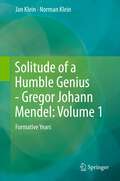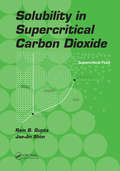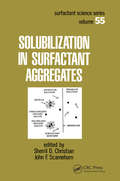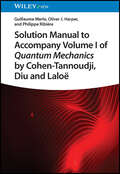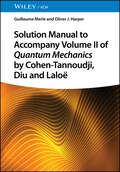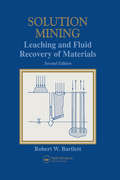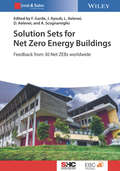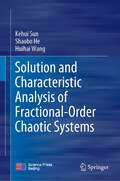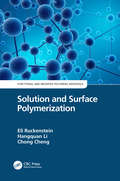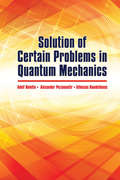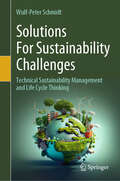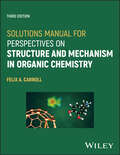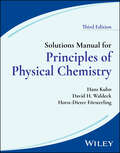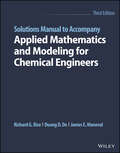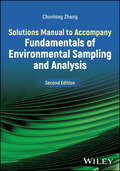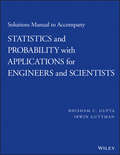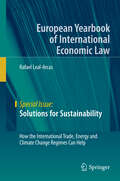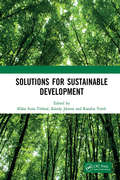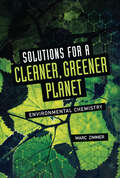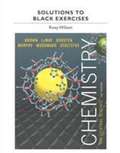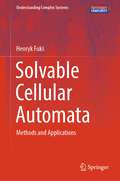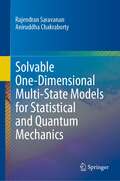- Table View
- List View
Solitude of a Humble Genius - Gregor Johann Mendel: Formative Years
by Norman Klein Jan KleinGregor Johann Mendel continues to fascinate the general public as well as scholars, the former for his life and the latter for his achievements. Solitude of a Humble Genius is a two-volume biography presenting Mendel in the context of the history of biology and philosophy, and in the context of the setting in which he lived and worked. In this first volume the authors set the stage for a new interpretation of Mendel's achievements and personality. The period of Mendel's life covered by this volume is critical to understanding why he saw what other biologists, including Charles Darwin, for example, didn't. In searching for clues to Mendel's thinking, the authors discuss at length the origin of his genes; the history of the region of his birth; they also spend a day and then the four seasons of the year with his family; and finally they examine the schooling he received, as well as the cultural and political influences he was exposed to. An indispensible part of the work is Norman Klein's artwork. In this first volume alone, it comprises nearly 80 original drawings and includes cartoons that enliven the narration, scenes from Mendel's life, portraits, and plans and drawings of the cities and buildings in which he lived, studied, and worked.
Solomon's Code: Humanity In A World Of Thinking Machines
by Olaf Groth Mark NitzbergA thought-provoking examination of artificial intelligence and how it reshapes human values, trust, and power around the world. Whether in medicine, money, or love, technologies powered by forms of artificial intelligence are playing an increasingly prominent role in our lives. As we cede more decisions to thinking machines, we face new questions about staying safe, keeping a job and having a say over the direction of our lives. The answers to those questions might depend on your race, gender, age, behavior, or nationality. New AI technologies can drive cars, treat damaged brains and nudge workers to be more productive, but they also can threaten, manipulate, and alienate us from others. They can pit nation against nation, but they also can help the global community tackle some of its greatest challenges—from food crises to global climate change. In clear and accessible prose, global trends and strategy adviser Olaf Groth, AI scientist and social entrepreneur Mark Nitzberg, along with seasoned economics reporter Dan Zehr, provide a unique human-focused, global view of humanity in a world of thinking machines.
Solubility in Supercritical Carbon Dioxide
by Ram B. Gupta Jae-Jin ShimSupercritical fluid extraction is an environmentally safe and cost-effective alternative to traditional organic solvents. Carbon dioxide is widely used as the solvent of choice for applications such as caffeine and nicotine extraction due to its mild critical temperature, nontoxicity, nonflammability, and low cost. Introducing the most complete col
Solubilization in Surfactant Aggregates
by Sherril D. Christian and John F ScamehornThis work covers topics ranging from fundamental studies of solubilization to practical technological applications of the phenomenon. It reviews the solubilization of organic materials into surfactant aggregates, including micelles, vesicles and admicelles. The book also details methods of measuring solubilization that utilize both classical and newer instrumental techniques. It is intended for physical, surface, colloid and surfactant chemists; chemical, environmental and civil engineers; and upper-level undergraduate and graduate students in these disciplines.
Solution Manual to Accompany Volume I of Quantum Mechanics by Cohen-Tannoudji, Diu and Laloë
by Guillaume Merle Oliver J. Harper Philippe RibiereSolution Manual to Accompany Volume I of Quantum Mechanics by Cohen-Tannoudji, Diu and Laloë Grasp the fundamentals of quantum mechanics with this essential set of solutions Quantum mechanics, with its counter-intuitive premises and its radical variations from classical mechanics or electrodynamics, is both among the most important components of a modern physics education and one of the most challenging. It demands both a theoretical grounding and a grasp of mathematical technique that take time and effort to master. Students working through quantum mechanics curricula generally practice by working through increasingly difficult problem sets, such as those found in the seminal Quantum Mechanics volumes by Cohen-Tannoudji, Diu and Laloë. This solution manual accompanies Volume I and offers the long-awaited detailed solutions to all 69 problems in this text. Its accessible format provides explicit explanations of every step, focusing on both the physical theory and the formal mathematics, to ensure students grasp all pertinent concepts. It also includes guidance for transferring the solution approaches to comparable problems in quantum mechanics. Readers also benefit from: Approximately 70 figures to clarify key steps and concepts Detailed explanations of problems concerning quantum mechanics postulates, mathematical tools, properties of angular momentum, and more This solution manual is a must-have for students in physics, chemistry, or the materials sciences looking to master these challenging problems, as well as for instructors looking for pedagogical approaches to the subject.
Solution Manual to Accompany Volume II of Quantum Mechanics by Cohen-Tannoudji, Diu and Laloë
by Guillaume Merle Oliver J. HarperProvides detailed solutions to all 47 problems in the seminal textbook Quantum Mechanics, Volume II With its counter-intuitive premises and its radical variations from classical mechanics or electrodynamics, quantum mechanics is among the most important and challenging components of a modern physics education. Students tackling quantum mechanics curricula generally practice by working through increasingly difficult problem sets that demand both a theoretical grounding and a solid understanding of mathematical technique. Solution Manual to Accompany Volume II of Quantum Mechanics by Cohen-Tannoudji, Diu and Laloë is designed to help you grasp the fundamentals of quantum mechanics by doing. This essential set of solutions provides explicit explanations of every step, focusing on the physical theory and formal mathematics needed to solve problems with varying degrees of difficulty. Contains in-depth explanations of problems concerning quantum mechanics postulates, mathematical tools, approximation methods, and moreCovers topics including perturbation theory, addition of angular momenta, electron spin, systems of identical particles, time-dependent problems, and quantum scattering theoryGuides readers on transferring the solution approaches to comparable problems in quantum mechanicsIncludes numerous figures that demonstrate key steps and clarify key concepts Solution Manual to Accompany Volume II of Quantum Mechanics by Cohen-Tannoudji, Diu and Laloë is a must-have for students in physics, chemistry, or the materials sciences wanting to master these challenging problems, as well as for instructors looking for pedagogical approaches to the subject.
Solution Mining: Leaching and Fluid Recovery of Materials
by Robert BartlettFirst published in 1998. This book offers a wealth of information on the rapidly expanding field of solution mining: yhe extraction of materials from the earth by leaching and fluid recovery. This is an introductory text for students and professional engineers that is comprehensive and emphases current practice and theory. Percolation leaching of fragmented ground is covered, as well as true and modified in situ teaching. Solution mining of gold, copper and uranium ores, several slats extracted from evaporates and brines, and sulfur are discussed. Mineral teaching chemistry and kinetics, hydrology (including flow equations for various wellfields and other fluid recovery systems), environmental containment and solution mining simulation models are also included.
Solution Sets for Net Zero Energy Buildings: Feedback from 30 Buildings Worldwide (Solar Heating and Cooling)
by François GardeNet Zero-Energy Buildings have been the object of numerous studies in recent years as various countries have set this performance level as a long-term goal of their energy policies. This book presents a unique study of 30 NZEBs that have been constructed and have had their performance measured for at least 12 months. The study is based upon an international collaborative research initiated by the International Energy Agency - the Solar Heating and Cooling Programme (SHC). It is the first book to evaluate building strategies in houses, educational buildings and offices that have been demonstrated to work in practice. It examines how the design challenges of climate and building type have been addressed, and to what extent the various design approaches have been successful. This book presents convincing evidence that a careful re-thinking of conventional design norms can achieve a far greater performance benefit than is normally feasible. It identifies `solution sets? that work at the whole building level and at the individual building design challenge level for each climate and building type. In doing so, the book provides guidance as to how to improve the design by learning from these cases. Unusually for a book of this type it has examples of buildings in what are conventionally labeled "hot" and "cold" climates. A simple process is proposed for the reader to commission the analysis of their own climate to assess not only the conventional measure of how hot or cold or humid it is, but also to assess its suitability to support other NZEB technical challenge solutions sets such as Daylight or Natural Ventilation or comfort based climate conditioning.
Solution and Characteristic Analysis of Fractional-Order Chaotic Systems
by Kehui Sun Shaobo He Huihai WangThis book highlights the solution algorithms and characteristic analysis methods of fractional-order chaotic systems. Fractal dimensions exist broadly in the study of nature and the development of science and technology. Fractional calculus has become a hot research area in nonlinear science. Fractional-order chaotic systems are an important part of fractional calculus. The book discusses the numerical solution algorithms and characteristic analysis of fractional-order chaotic systems and introduces the techniques to implement the systems with circuits. To facilitate a quick grasp, the authors present examples from their years of work in the appendix. Intended for graduate students and researchers interested in chaotic systems, the book helps one to build a theoretical and experimental foundation for the application of fractional-order chaotic systems.
Solution and Surface Polymerization
by Eli Ruckenstein, Hangquan Li and Chong ChengComprising one volume of Functional and Modified Polymeric Materials, Two-Volume Set, this well-organized collection of papers by Professor Eli Ruckenstein and co-workers focuses on functional and modified polymeric materials prepared mainly through solution polymerization and surface polymerization. Although solution polymerization has been broadly utilized for the preparation of polymeric materials, the book shows significant approaches to special classes of polymeric materials including functional polymers by living ionic polymerization, degradable and decrosslinkable polymers, semi- and interpenetrating polymer network pervaporation membranes, and soluble conducting polymers. It also focuses on preparing and modifying conductive surface of polymer or polymer-based materials.
Solution of Certain Problems in Quantum Mechanics (Dover Books on Physics)
by A. Bolotin A. Pozamantir A. RaudeliunasIntended for advanced undergraduates and graduate students in mathematics, physics, and chemistry, this work teaches problem-solving using the theory of special functions. The concise treatment presents the theory methodically and in detail to a wide variety of problems in atomic and molecular physics. The overall applicability of this method and its extension to solving these problems are discussed with attention to detail seldom found in textbooks of this level.Starting with a brief introduction to the hypergeometric equations and their properties, a step-by-step method consisting of six distinct parts illustrates how to address typical problems in quantum physics in a simple and uniform fashion. This technique can also be applied to the solution of other problems, for which the Schrödinger equation can be reduced by some means to an equation of the hypergeometric type. Topics include the discrete spectrum eigenfunctions, linear harmonic oscillators, Kratzer molecular potential, and the rotational correction to the Morse formula. The text concludes with an Appendix that presents an original Fourier transform-based method for converting multicenter integrals to a single center.
Solutions For Sustainability Challenges: Technical Sustainability Management and Life Cycle Thinking
by Wulf-Peter SchmidtThe book is intended as a primary resource for Chief Sustainability Officers (CSOs), all professionals with interest in sustainability as well as sustainability courses at CBS International Business School and other universities. It starts by reviewing the challenges of sustainability (environmental, social, economic, and governance). The basics of life cycle thinking are explained, looking at Life Cycle Assessment/LCA, Life Cycle Costing/LCC, Social LCAs, and Life Cycle Management. These are applied to sustainable strategy development, sustainable product development, sustainable supply chain management and logistics, sustainable production, sustainable consumption, circular economy, sustainable digitalization, sustainable finance, sustainable employee relations, sustainable advocacy, law and policymaking, etc.—to show how each person in each profession and role can act sustainably and how to democratize sustainability.
Solutions Manual for Perspectives on Structure and Mechanism in Organic Chemistry
by Felix A. CarrollSOLUTIONS MANUAL FOR PERSPECTIVES ON STRUCTURE AND MECHANISM IN ORGANIC CHEMISTRY Based on the author’s first-hand classroom experience, this solutions manual complements the 3rd edition of Perspectives on Structure and Mechanism in Organic Chemistry. The solutions to the 438 textbook problems help students increase their understanding of physical organic chemistry, and more than 550 references stimulate their engagement with the chemical literature.
Solutions Manual for Principles of Physical Chemistry, 3rd Edition, Solutions Manual
by Hans Kuhn Horst-Dieter Försterling David H. WaldeckThis is a Solutions Manual to Accompany with solutions to the exercises in the main volume of Principles of Physical Chemistry, Third Edition. This book provides a unique approach to introduce undergraduate students to the concepts and methods of physical chemistry, which are the foundational principles of Chemistry. The book introduces the student to the principles underlying the essential sub-fields of quantum mechanics, atomic and molecular structure, atomic and molecular spectroscopy, statistical thermodynamics, classical thermodynamics, solutions and equilibria, electrochemistry, kinetics and reaction dynamics, macromolecules, and organized molecular assemblies. Importantly, the book develops and applies these principles to supramolecular assemblies and supramolecular machines, with many examples from biology and nanoscience. In this way, the book helps the student to see the frontier of modern physical chemistry developments. The book begins with a discussion of wave-particle duality and proceeds systematically to more complex chemical systems in order to relate the story of physical chemistry in an intellectually coherent manner. The topics are organized to correspond with those typically given in each of a two course semester sequence. The first 13 chapters present quantum mechanics and spectroscopy to describe and predict the structure of matter: atoms, molecules, and solids. Chapters 14 to 29 present statistical thermodynamics and kinetics and applies their principles to understanding equilibria, chemical transformations, macromolecular properties and supramolecular machines. Each chapter of the book begins with a simplified view of a topic and evolves to more rigorous description, in order to provide the student (and instructor) flexibility to choose the level of rigor and detail that suits them best. The textbook treats important new directions in physical chemistry research, including chapters on macromolecules, principles of interfaces and films for organizing matter, and supramolecular machines -- as well as including discussions of modern nanoscience, spectroscopy, and reaction dynamics throughout the text.
Solutions Manual for Quantitative Chemical Analysis
by Daniel C. Harris Charles A. LucyThe 10th edition of Quantitative Chemical Analysis continues to set the standard for learning analytical chemistry with distinguished writing, the most up-to-date content, and now the acclaimed SaplingPlus program, supporting exceptional problem solving practice. New author Charles Lucy joins Dan Harris, infusing additional subject expertise and classroom experience into the 10th edition.
Solutions Manual to Accompany Applied Mathematics and Modeling for Chemical Engineers
by Duong D. Do Richard G. Rice James E. ManevalThis book is a Solutions Manual to accompany Applied Mathematics and Modeling for Chemical Engineers, Third Edition. There are many examples provided as homework in the original text and the solution manual provides detailed solutions of many of these problems that are in the parent book Applied Mathematics and Modeling for Chemical Engineers, Third Edition.
Solutions Manual to Accompany Fundamentals of Environmental Sampling and Analysis
by Chunlong ZhangThis is the Solutions Manual to accompany Fundamentals of Environmental Sampling and Analysis, Second Edition. It provides solutions to the exercises and problems found in the main volume This book introduces a comprehensive overview on the fundamentals and applications of environmental sampling and analysis for students in environmental science and engineering as well as environmental professionals involved in sampling and analytical work. The book details fundamentals of sampling, selection of standard methods, QA/QC, sample preparation, chemical and instrumental principles, and method applications to various contaminants in environmental matrices (air, water, soil, waste, and biological samples). The book gives an integrated introduction to sampling and analysis – both are essential to quality environmental data. For example, contrary to other books that introduce a specific area of sampling and analysis, this text provides a balanced mix of field sampling and laboratory analysis, essential knowledge in chemistry/statistics/hydrology/regulations, wet chemical methods for conventional chemicals as well as various modern instrumental techniques for contaminants of emerging concerns. The new edition adds three standalone chapters regarding the basics of analytical and organic chemistry, environmental data analysis, mass spectrometry and other significant amounts of new materials such as time-integrated passive sampling, incremental sampling, green sample preparation, Raman spectroscopy, chiral separation, and non-target analysis. In addition, the second edition provides more examples, visual aids, case studies, and end-of-chapter exercise problems to enhance a better understanding of the fundamentals of environmental sampling and analysis while incorporating current literature (mostly peer-reviewed journal papers) regarding the applications and challenges in the field of environmental sampling and analysis.
Solutions Manual to Accompany Statistics and Probability with Applications for Engineers and Scientists
by Bhisham C. Gupta Irwin GuttmanA solutions manual to accompany Statistics and Probability with Applications for Engineers and ScientistsUnique among books of this kind, Statistics and Probability with Applications for Engineers and Scientists covers descriptive statistics first, then goes on to discuss the fundamentals of probability theory. Along with case studies, examples, and real-world data sets, the book incorporates clear instructions on how to use the statistical packages Minitab® and Microsoft® Office Excel® to analyze various data sets. The book also features:Detailed discussions on sampling distributions, statistical estimation of population parameters, hypothesis testing, reliability theory, statistical quality control including Phase I and Phase II control charts, and process capability indicesA clear presentation of nonparametric methods and simple and multiple linear regression methods, as well as a brief discussion on logistic regression methodComprehensive guidance on the design of experiments, including randomized block designs, one- and two-way layout designs, Latin square designs, random effects and mixed effects models, factorial and fractional factorial designs, and response surface methodologyA companion website containing data sets for Minitab and Microsoft Office Excel, as well as JMP ® routines and resultsAssuming no background in probability and statistics, Statistics and Probability with Applications for Engineers and Scientists features a unique, yet tried-and-true, approach that is ideal for all undergraduate students as well as statistical practitioners who analyze and illustrate real-world data in engineering and the natural sciences.
Solutions and Problem-Solving Manual to Accompany Pierce’s Genetics Essentials: Concepts And Connections (Fourth Edition)
by Pierce Choi McCallumSolutions and Problem-Solving Manual to Accompany Pierce’s Genetics Essentials
Solutions for Sustainability: How the International Trade, Energy and Climate Change Regimes Can Help (European Yearbook of International Economic Law)
by Rafael Leal-ArcasThis book explores links and synergies between international trade and two of the most urgent challenges of the 21st century: achieving sustainable energy (i.e., energy that is affordable, secure, and clean) and mitigating climate change. It takes the unique approach of not only examining how international trade can help achieve energy and climate goals, but also the impact of emerging tools and technologies such as smart grids and demand response, and the potential role and impact of citizens and prosumers. The book analyzes energy- and trade-related regulations in a range of jurisdictions to assess how conducive the regulation is towards achieving sustainable energy, and identifies gaps and overlaps in the existing legal framework.
Solutions for Sustainable Development: Proceedings of the 1st International Conference on Engineering Solutions for Sustainable Development (ICESSD 2019), October 3-4, 2019, Miskolc, Hungary
by Károly Jármai Klára Szita Tóthné Katalin VoithThe first International Conference on Engineering Solutions and Sustainable Development which is organized by the University of Miskolc, Hungary is a significant and timely initiative creating the capacity of engineering students, educators, practicing engineers and industries to demonstrate values, problem solving skills, knowledge, and attitude that are required to apply the principles of sustainable development throughout their professional career.The aim of the ICESSD conference was creating an interdisciplinary platform for researchers and practitioners to present and discuss the most recent innovations, trends, and concerns as well as practical challenges encountered and solutions adopted in the fields of Technical and Environmental Science. The conference covers the following topics: Process Engineering, Modelling and Optimisation Sustainable and Renewable Energy and Energy Engineering Waste Management and Reverse Logistics Environmental Management and Ecodesign Circular Economy and Life Cycle Approaches Smart Manufacturing and Smart Buildings Innovation and Efficiency Earth Science Academics, scientists, researchers and professionals from different countries and continents have contributed to this book.
Solutions for a Cleaner, Greener Planet: Environmental Chemistry
by Marc ZimmerMany of the most toxic materials on Earth—from arsenic to plutonium—occur naturally, but manufacturers have also used them in products such as paints, plumbing, pesticides, nuclear fuel, and weaponry. Without careful management, toxins can leach into groundwater or pollute our environment. Exposure to toxins leads to various cancers, impairment of the immune and reproductive systems, as well as cognitive problems. What can be done? Solutions include a wide range of infrastructure approaches, such as better water filtration, governmental and manufacturing regulations, outright bans on certain chemicals, careful monitoring, and the use of alternative fuels. Learn more about key contaminants and their impact on health, as well as solutions on a global and individual level.
Solutions to Black Exercises for Chemistry
by The Editors at the PearsonThis was written to enhance the end-of-chapter exercises by providing documented solutions for 1600 problems not answered in the appendix of the text
Solvable Cellular Automata: Methods and Applications (Understanding Complex Systems)
by Henryk FukśThe main focus of the book is solvability of cellular automata, that is, expressing the state of a given cell after a given number of steps by an explicit formula. The author considers solutions of two types of initial value problems for cellular automata, the deterministic one and the probabilistic one. In the first chapter the basic concepts of cellular automata theory are introduced. Deterministic initial value problem is introduced next and solutions for selected simple rules are also presented. In the following chapters various techniques for solving the deterministic problem are introduced, using elementary CA rules of increasing complexity as examples. The second part of the book introduces the concept of probability measure in the context of cellular automata and the probabilistic initial value problem for both deterministic and probabilistic rules. The book is amply illustrated with examples and applications such as the density classification problem, phase transitions in traffic models or the diffusion of innovations model. In the appendix, solution formulae (both deterministic and probabilistic) for over 60 elementary cellular automata rules are listed. Ruelle-Frobenius-Perron equations for all 88 minimal elementary cellular automata are also provided.
Solvable One-Dimensional Multi-State Models for Statistical and Quantum Mechanics
by Rajendran Saravanan Aniruddha ChakrabortyThis book highlights the need for studying multi-state models analytically for understanding the physics of molecular processes. An intuitive picture about recently solved models of statistical and quantum mechanics is drawn along with presenting the methods developed to solve them. The models are relevant in the context of molecular processes taking place in gaseous phases and condensed phases, emphasized in the introduction. Chapter 1 derives the arisal of multi-state models for molecular processes from the full Hamiltonian description. The model equations are introduced and the literature review presented in short. In Chapter 2, the time-domain methods to solve Smoluchowski-based reaction-diffusion systems with single-state and two-state descriptions are discussed. Their corresponding analytical results derive new equilibrium concepts in reversible reactions and studies the effect of system and molecular parameters in condensed-phase chemical dynamics. In Chapter 3, time-domain methods to solve quantum scattering problems are developed. Along side introducing a brand new solvable model in quantum scattering, it discusses transient features of quantum two-state models. In interest with electronic transitions, a new solvable two-state model with localized non-adiabatic coupling is also presented. The book concludes by proposing the future scope of the model, thereby inviting new research in this fundamentally important and rich applicable field.
